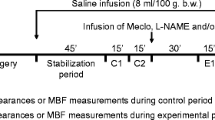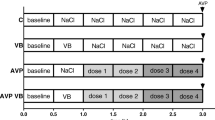Abstract
Continuous infusion of intravenous prostaglandin E1 (PgE1, 2.5 μg/kg/min) was used to determine how vasodilation affects oxygen consumption of the microvascular wall and tissue pO2 in the hamster window chamber model. While systemic measurements (mean arterial pressure and heart rate) and central blood gas measurements were not affected, PgE1 treatment caused arteriolar (64.6 ± 25.1 μm) and venular diameter (71.9 ± 29.5 μm) to rise to 1.15 ± 0.21 and 1.06 ± 0.19, respectively, relative to baseline. Arteriolar (3.2 × 10−2 ± 4.3 × 10−2 nl/s) and venular flow (7.8 × 10−3 ± 1.1 × 10−2/s) increased to 1.65 ± 0.93 and 1.32 ± 0.72 relative to baseline. Interstitial tissue pO2 was increased significantly from baseline (21 ± 8 to 28 ± 7 mmHg; P < 0.001). The arteriolar vessel wall gradient, a measure of oxygen consumption by the microvascular wall decreased from 20 ± 6 to 16 ± 3 mmHg (P < 0.001). The arteriolar vessel wall gradient, a measure of oxygen consumption by the vascular wall, decreased from 20 ± 6 to 16 ± 3 mmHg (P < 0.001). This reduction reflects a 20% decrease in oxygen consumption by the vessel wall and up to 50% when cylindrical geometry is considered. The venular vessel wall gradient decreased from 12 ± 4 to 9 ± 4 mmHg (P < 0.001). Thus PgE1-mediated vasodilation has a positive microvascular effect: enhancement of tissue perfusion by increasing flow and then augmentation of tissue oxygenation by reducing oxygen consumption by the microvascular wall.


Similar content being viewed by others
References
Bevan JA, Joyce EH, Wellman GC (1988) Flow-dependent dilation in a resistance artery still occurs after endothelium removal. Circ Res 63:980–985
Bihari DJ, Tinker J (1988) The therapeutic value of vasodilator prostaglandins in multiple organ failure associated with sepsis. Intensive Care Med 15(1):2–7
Brinkmann A, Seeling W, Wolf CF, Kneitinger E, Vogeser F, Rockemann M, Bruckner U, Radermacher P, Buchler M, Georgieff M (1997) The impact of prostanoids on pulmonary gas exchange during abdominal surgery with mesenteric traction. Anesth Analg 85(2):274–280
Buerk DG, Tsai AG, Intaglietta M, Johnson PC (1998) In vivo hamster skin fold tissue pO2 measurements by phosphorescence quenching and recessed pO2 microelectrodes are in agreement. Microcirculation 5:219–225
Carlson LA, Eriksson I (1973) Femoral-artery infusion of prostaglandin E1 in severe peripheral vascular disease. Lancet 1:155–156
Colantuoni A, Bertuglia S, Intaglietta M (1984) Quantitation of rhythmic diameter changes in arterial microcirculation. Am J Physiol 246:H508–H517
Creutzig A, Lehmacher W, Elze M (2004) Meta-analysis of randomised controlled prostaglandin E1 studies in peripheral arterial occlusive disease stages III and IV. Vasa 33:137–144
Dünser MW, Mayr AJ, Tur A, Pajk W, Friesenecker B, Knotzer H, Ulmer H, Hasibeder WR (2003) Ischemic skin lesions as a complication of continuous vasopressin infusion in catecholamine-resistant vasodilatory shock: incidence and risk factors. Crit Care Med 31:1394–1398
Endrich B, Asaishi K, Götz A, Messmer K (1980) Technical report: a new chamber technique for microvascular studies in unanaesthetized hamsters. Res Exp Med (Berl) 177:125–134
Eichelbronner O, Reinelt H, Wiedeck H, Mezody M, Rossaint R, Georgieff M, Radermacher P (1995) Aerosolized prostacyclin and inhaled nitric oxide in septic shock—different effects on splanchnic oxygenation? Intensive Care Med 21(5):414–421
Friesenecker B, Tsai AG, Dunser MW, Mayr AJ, Martini J, Knotzer H, Hasibeder W, Intaglietta M (2004) Oxygen distribution in microcirculation after arginine vasopressin-induced arteriolar vasoconstriction. Am J Physiol Heart Circ Physiol 287:H1792–1800
Fukuda S, Morioka M, Tanaka T, Shimoji K (1992) Prostaglandin E1-induced vasorelaxation in porcine coronary arteries. J Pharmacol Exp Ther 260(3):1128–1132
Gladis-Villanueva M, Schror K (1996) Synergistic inhibition of human polymorphonuclear function by prostaglandin E1 and linsidomine. J Pharm Pharmacol 48(7):706–711
Groebe K (1995) An easy-to-use model for O2 supply to red muscle. Validity of assumptions, sensitivity to errors in data. Biophys J Apr 68(4):1246–1269
Hangai-Hoger N, Tsai AG, Friesenecker B, Cabrales P, Intaglietta M (2005) Microvascular oxygen delivery and consumption following treatment with verapamil. Am J Physiol Heart Circ Physiol Apr 288(4):H1515–1520
Hayes MA, Yau EH, Hinds CJ, Watson JD (1992) Symmetrical peripheral gangrene: association with noradrenaline administration. Intensive Care Med 18:433–436
Hedlund H, Andersson KE (1985) Contraction and relaxation induced by some prostanoids in isolated human penile erectile tissue and cavernous artery. J Urol 134:1245–1250
Joynt G, Doedens L, Lipman J, Bothma P (1996) High-dose adrenaline with low systemic vascular resistance and symmetrical peripheral gangrene. S Afr J Surg 34:99–101
Kerger H, Groth G, Kalenka A, Vajkoczy P, Tsai AG, Intaglietta M (2003) pO2 measurements by phosphorescence quenching: characteristics and applications of an automated system. Microvasc Res 65:32–38
Koller A, Kaley G (1990a) Endothelium regulates skeletal muscle microcirculation by a blood flow velocity-sensing mechanism. Am J Physiol 258:H916–H920
Koller A, Kaley G (1990b) Prostaglandins mediate arteriolar dilation to increased blood flow velocity in skeletal muscle microcirculation. Circ Res 67:529–534
Koller A, Kaley G (1990c) Role of endothelium in reactive dilation of skeletal muscle arterioles. Am J Physiol 259:H1313–1316
Kreienbuhl G, Strittmatter J, Ayim E (1976) Blood gas analyses of hibernating hamsters and dormice. Pflügers Arch 366:167–172
Lipowsky HH, Zweifach BW (1978) Application of the “two-slit” photometric technique to the measurement of microvascular volumetric flow rates. Microvasc Res 15:93–101
Martini J, Tsai AG, Cabrales P, Johnson PC, Intaglietta M (2006) Increased cardiac output and microvascular blood flow during mild hemoconcentration in the hamster window model. Am J Physiol Heart Circ Physiol 291(1):H310–H317
Messina EJ, Weiner R, Kaley G (1974) Microcirculatory effects of prostaglandins E1, E2, and A1 in the rat mesentery and cremaster muscle. Microvasc Res 8:77–89
Moncada S, Vane JR (1978a) Pharmacology and endogenous roles of prostaglandin endoperoxides, thromboxane A2, and prostacyclin. Pharmacol Rev 30:293–331
Moncada S, Vane JR (1978b) Unstable metabolites of arachidonic acid and their role in haemostasis and thrombosis. Br Med Bull 34:129–135
Nolte D, Botzlar A, Hecht R, Csapo C, Menger MD, Messmer K (1994) Diaspirin crosslinked hemoglobin: evaluation of effects on the microcirculation of striated muscle. Artif Cells Blood Substit Immobil Biotechnol 22(3):587–592
Radermacher P, Buhl R, Santak B, Klein M, Kniemeyer HW, Becker H, Tarnow J (1996) The effects of prostacyclin on gastric intramucosal pH in patients with septic shock. Intensive Care Med 22(9):880–887
Shibata M, Ichioka S, Kamiya A (2005a) Estimating oxygen consumption rates of arteriolar walls under physiological conditions in rat skeletal muscle. Am J Physiol Heart Circ Physiol 289(1):H295–H300
Shibata M, Ichioka S, Kamiya A (2005b) Nitric oxide modulates oxygen consumption by arteriolar walls in rat skeletal muscle. Am J Physiol Heart Circ Physiol 289(6):H2673–H2679
Shibata M, Qin K, Ichioka S, Kamiya A (2006) Vascular wall energetics in arterioles during nitric oxide-dependent and -independent vasodilation. J Appl Physiol 100:1793–1798
Torres Filho IP, Intaglietta M (1993) Microvessel pO2 measurements by phosphorescence decay method. Am J Physiol 265:H1434–H1438
Tsai AG, Intaglietta M (2001) High viscosity plasma expanders: volume restitution fluids for lowering the transfusion trigger. Biorheology 38:229–237
Tsai AG, Friesenecker B, Mazzoni MC, Kerger H, Buerk DG, Johnson PC, Intaglietta M (1998) Microvascular and tissue oxygen gradients in the rat mesentery. Proc Natl Acad Sci USA 95:6590–6595
Tsai AG, Johnson PC, Intaglietta M (2003) Oxygen gradients in the microcirculation. Physiol Rev 83:933–963
Tsai AG, Cabrales P, Intaglietta M (2004) Microvascular perfusion upon exchange transfusion with stored red blood cells in normovolemic anemic conditions. Transfusion 44(11):1626–1634
Tsai AG, Cabrales P, Manjula BN, Acharya SS, Winslow RM, Intaglietta M (2006) Dissociation of local nitric oxide concentration and vasoconstriction in the presence of cell-free hemoglobin oxygen carriers. Blood (in press)
Ye JM, Colquhoun EQ, Clark MG (1990) A comparison of vasopressin and noradrenaline on oxygen uptake by perfused rat hind limb, intestine, and mesenteric arcade suggests that it is part due to contractile work by blood vessels. Gen Pharmacol 21:805–810
Acknowledgments
This research was conducted with the financial support of the Österreichische Nationalbank, Jubiläumsfondsprojekt 5526; “Fonds zur Förderung der Forschung an den Universitätskliniken Innsbruck,” MFF 49. This study was also supported by the USPHS Bioengineering Research Partnership grant R24-HL 64395, grants R01-HL 62318, R01-HL 62354 and R01-HL 76182.
Author information
Authors and Affiliations
Corresponding author
Rights and permissions
About this article
Cite this article
Friesenecker, B., Tsai, A.G., Dünser, M.W. et al. Lowered microvascular vessel wall oxygen consumption augments tissue pO2 during PgE1-induced vasodilation. Eur J Appl Physiol 99, 405–414 (2007). https://doi.org/10.1007/s00421-006-0360-0
Accepted:
Published:
Issue Date:
DOI: https://doi.org/10.1007/s00421-006-0360-0




